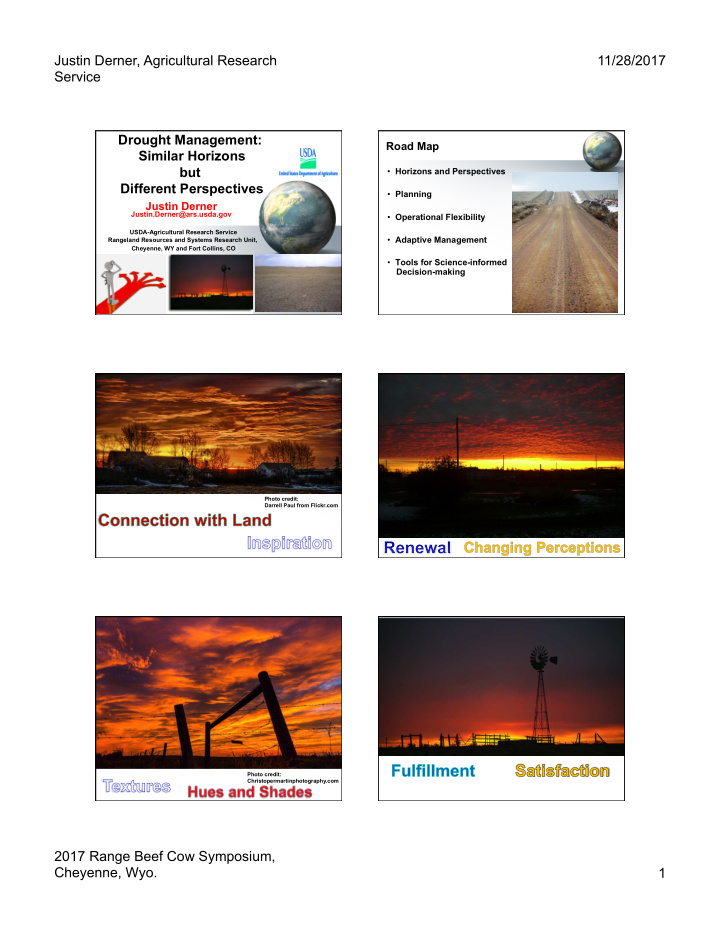



Justin Derner, Agricultural Research 11/28/2017 Service Drought Management: Road Map Similar Horizons but • Horizons and Perspectives Different Perspectives • Planning Justin Derner Justin.Derner@ars.usda.gov • Operational Flexibility USDA-Agricultural Research Service • Adaptive Management Rangeland Resources and Systems Research Unit, Cheyenne, WY and Fort Collins, CO • Tools for Science-informed Decision-making Photo credit: Darrell Paul from Flickr.com Photo credit: Christopermartinphotography.com 2017 Range Beef Cow Symposium, Cheyenne, Wyo. 1
Justin Derner, Agricultural Research 11/28/2017 Service 20 th Century Droughts Recent Droughts 2012 2017 Woodhouse and Overpeck, 1998 Planning Interannual Variability Central Plains Experimental Range, CO 25.0 Annual Precipitation (inches) 22.5 20.0 17.5 15.0 12.5 10.0 7.5 Mean: 13.40 5.0 Max: 22.88 (1967) Min: 4.31 (1964) 2.5 0.0 1940 1945 1950 1955 1960 1965 1970 1975 1980 1985 1990 1995 2000 2005 2010 2015 What Drought Management Drought Planning Strategies do Ranchers Use? How many producers had a drought management plan? 4 in 10 producers do 60% not have a drought plan How many producers thought drought would be more influential in their management plans in the future than past? 40% Kachergis et al. Ecosphere 5(6):77. http://dx.doi.org/10.1890/ES13-00402.1 2017 Range Beef Cow Symposium, Cheyenne, Wyo. 2
Justin Derner, Agricultural Research 11/28/2017 Service Drought: Preparing? Proactive “…we do have a drought plan, and reactive it’s kind of pessimistic plan in drought that you just figure the drought management is going to be here periodically strategies and you keep things at a conservative level , so when it does come it doesn’t hit so hard. Not that we aren’t Limited use affected, but we aren’t currently, but affected as much.” potential is high for “That’s why we run a smaller flexibility cow herd. That’s why we’re kind of under stocked.” Kachergis et al. Ecosphere 5(6):77. Drought: Opportunity? Operational Flexibility “..instead of seeing it (drought) as an obstacle, you see it as “...if you have more of a diverse type of a catalyst to make changes you might not ordinarily do.” livestock (enterprise), your options of being able to de-stock are so much easier so when you have this abrupt drought…when you have a diverse Drought as a group of cattle… you’re not looking Change Agent at trying to get rid of pairs, which is hard to do right now . Yearlings are a lot easier to unload, so that’s just another reason I have gone the way “So the last drought was just an expensive education to I’m going is it makes you more flexible do something different. I think anybody that went through in those decisions.” the last drought and didn’t do something before this drought is crazy. And I think most people are doing something.” Forage Production Variability Possible Flexible Strategies • Transition from 100% cow-calf to cow- calf-yearling operations 3000 “really good years” 2750 – Several operations using 2/3 of long-term Forage Production (kg/ha) 2500 forage carrying capacity for cow herd, flex Difficulty for 2250 with yearlings on the rest ranchers is 2000 – Can markedly reduce selling of cow matching this 1750 genetics in dry/drought years forage 1500 • Retain more heifer calves in fall 1250 production Photo credit – David Augustine variability 1000 – If extra forage, can either breed or send to with animal 750 feedlot after grass management 500 – If dry, heifers can be sold or sent to feedlot “really bad years” 250 flexibility • Dry cow grazing in late spring/summer across years. 1982 1984 1986 1988 1990 1992 1994 1996 1998 2000 2002 2004 2006 2008 2010 2012 2014 – If extra forage, can keep or purchase dry cows in spring and add weight Data from USDA-ARS, Cheyenne, WY, Derner et al. 2017 Range Beef Cow Symposium, Cheyenne, Wyo. 3
Justin Derner, Agricultural Research 11/28/2017 Service Adaptive Management Four general strategies for dealing with drought: 1) predict it with forecasting tools 2) respond by adjusting animal numbers or length of grazing season 3) employ conservative stocking 4) use inherent spatial variability Derner and Augustine 2016 Rangelands 38:211-215 Tools for Science-Informed Current Conditions Decision-making • Current conditions • Outlooks • Seasonal forecasts • Longer-term climatological influences Outlooks Seasonal Forecasts http://www.cpc.ncep.noaa.gov/ 2017 Range Beef Cow Symposium, Cheyenne, Wyo. 4
Justin Derner, Agricultural Research 11/28/2017 Service Longer-term Climatological Influences Warm Phase Warm Phase Atlantic Multidecadal Oscillation (AMO) Pacific Decadal Oscillation (PDO) A= PDO warm, AMO cold C= PDO warm, AMO warm 2013 to cold phase (current conditions) 1930s Dust Bowl High Dust Variability Bowl And Years Drought 2014 to warm phase D= PDO cold, AMO warm B= PDO cold, AMO cold (2000 to 2013) (mid-1960s to mid-1970s) 1950s drought period Take Home Messages GrassCast • Horizons and Perspectives • Planning • Operational Flexibility An Experimental Projection For Grassland Productivity • Adaptive Management In the Great Plains • Tools for Science-informed Justin Derner and Dannele Peck USDA Northern Plains Climate Hub Decision-making William (Bill) Parton June 12 Colorado State University Brian Fuchs National Drought Mitigation Center 2017 Range Beef Cow Symposium, Cheyenne, Wyo. 5
Justin Derner, Agricultural Research 11/28/2017 Service Questions? Justin.Derner@ars.usda.gov 2017 Range Beef Cow Symposium, Cheyenne, Wyo. 6
Recommend
More recommend